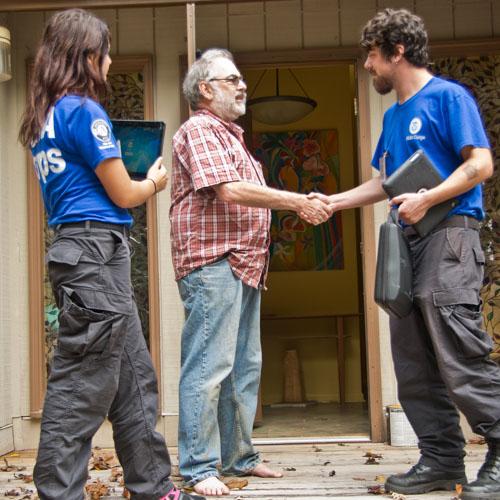Often the first to respond and the last to leave, AmeriCorps partners with federal, state, and local agencies and nonprofit organizations for disaster preparedness, response, recovery, and resiliency. The Disaster Services Unit leads coordination efforts across all phases of disaster services, providing technical assistance, volunteer management, training support, and more. Learn more about AmeriCorps’ disaster services framework.

800K+
AmeriCorps members and AmeriCorps Seniors volunteers provided disaster services

200+
disasters responded to over the last 30 years
Active and Recent Responses
 AmeriCorps’ expertly trained Disaster Response Team serves in national disaster response efforts by supporting shelter operations, call centers, volunteer and donation management, muck and gut operations, blue-roof tarping and debris cleanup, among other services.
AmeriCorps’ expertly trained Disaster Response Team serves in national disaster response efforts by supporting shelter operations, call centers, volunteer and donation management, muck and gut operations, blue-roof tarping and debris cleanup, among other services.
Disaster Support Services
AmeriCorps supports a range of immediate community needs through a coordinated response through agency and locally led efforts.
- Training and Technical Assistance: Equipping community leaders with resources for effective disaster recovery, ongoing training for members and staff, and national and local partner relationship building.
- Direct Response and Coordination: Mucking and gutting, debris removal, sheltering and feeding, volunteer management, donations and supplies management, and call center operations and data management.
- Mitigation and Resilience Planning: Disaster preparedness education and training for communities, natural debris clearing and conducting prescribed burns for disaster mitigation, and long-term recovery planning and development.
Agency and Locally Led Efforts
AmeriCorps staff, members, and volunteers are trained and prepared to activate in response to federally declared disasters, while AmeriCorps grantees operate alongside state and local governments to marshal their federal dollars and resources to meet community needs following a disaster.
AmeriCorps State and National
Programs often incorporate disaster response into their regular work with AmeriCorps, where members assist with preparation, response, and recovery tasks. If affected by a disaster, programs may temporarily shift to focus on response efforts, managing volunteers, and aiding survivors.
AmeriCorps NCCC
Members engage in disaster response projects such as preparedness education, home rebuilding, and debris clearing. AmeriCorps NCCC teams can be deployed to assist in disasters, often working with local, state, tribal, and federal partners.
AmeriCorps NCCC FEMA Corps
AmeriCorps NCCC members in FEMA Corps deploy with FEMA during disasters, primarily at the Joint Field Office, where they assist with disaster survivor assistance, logistics support, public assistance projects, and Geographic Information System mapping.
AmeriCorps VISTA
Members can collaborate with partner organizations responding to disasters or work with local organizations. Programs may temporarily shift to focus on disaster response activities like coordinating volunteers, managing donations, or overseeing call center operations.
AmeriCorps Seniors
AmeriCorps Seniors volunteers assist organizations involved in disaster response within their communities. AmeriCorps Seniors RSVP volunteers serve in their communities in various roles, such as food assistance, donations management, call center support, and Volunteer Reception Center support.
Disaster Staff Cadre
The AmeriCorps Disaster Cadre is a team of federal staff deployed during disasters to assist with specific activities, special projects, and to enhance disaster management partnerships and preparedness. They support the Disaster Services Unit.
Stories from the Ground
Read some of the stories of AmeriCorps members who support their communities:
Benefits for AmeriCorps Members and AmeriCorps Seniors Volunteers
Segal AmeriCorps Education Award
Receive an education award to repay qualified student loans and cover current expenses at eligible institutions.
Learn moreSchools of National Service
AmeriCorps partners with hundreds of higher education institutions to support college access.
Learn moreEmployers of National Service
Employers of National Service builds a talent pipeline to connect AmeriCorps and Peace Corps alumni with employers.
Learn more